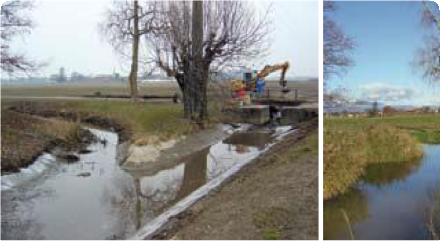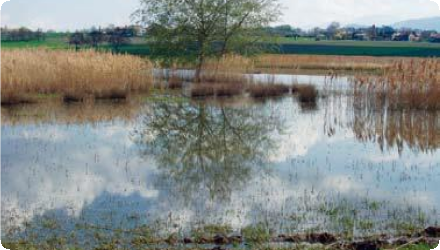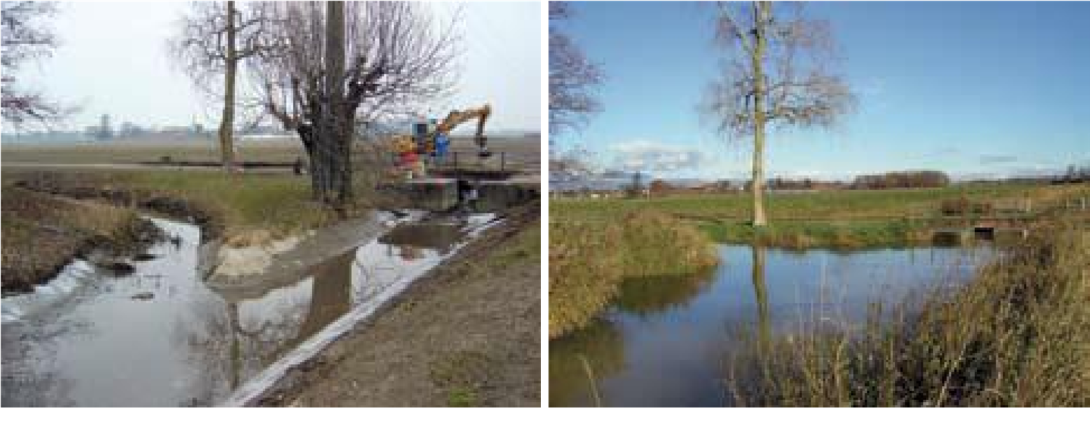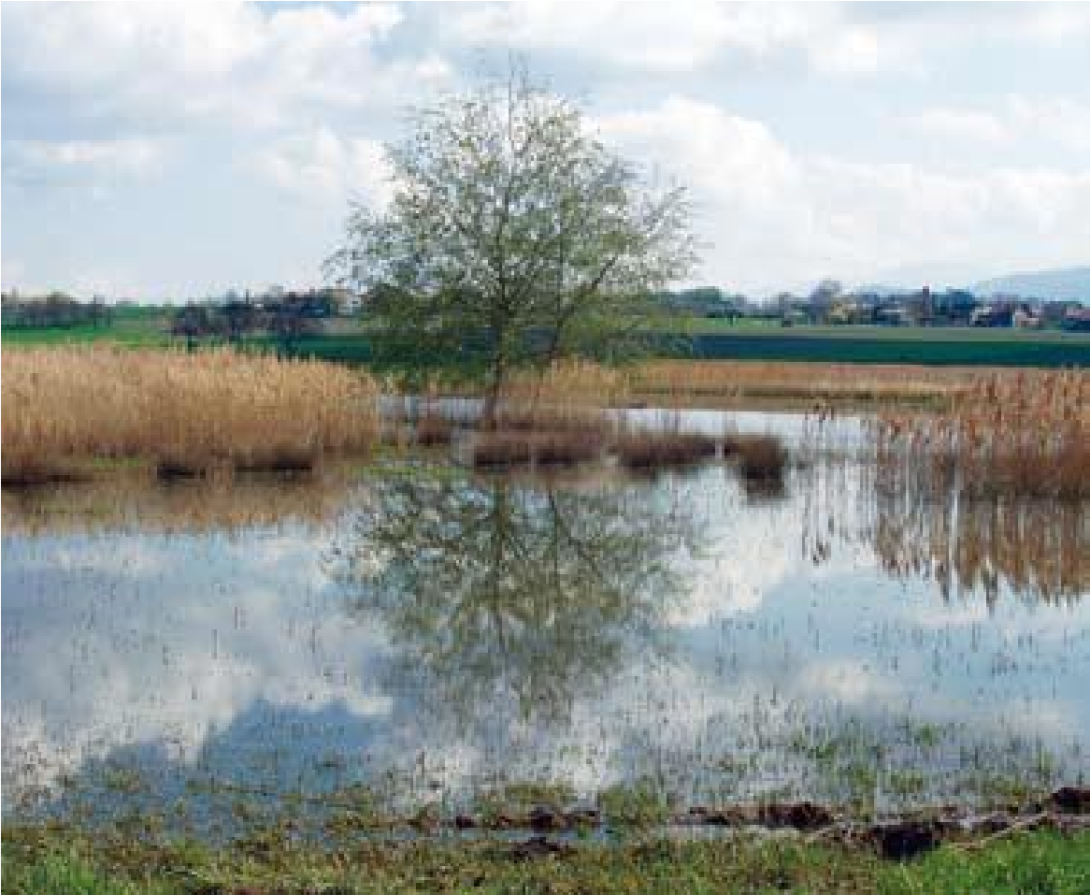Last update
2025
Summary
Located in eastern Geneva canton, the Seymaz renaturation replaces concrete channelization with a softer, wider river corridor and recreates marshland, under the canton’s long-running programme to improve ecological and landscape quality and reduce flood risk by managing peak flows. Governance has relied on the “Charte Seymaz” negotiation forum and a management group to coordinate local arrangements; land tenure and agricultural impacts were key constraints that required dialogue and compensation for farmers.
Since 2020 the canton has consolidated and showcased results (book + short film). In 2024–25 a new phase at Bel-Air (Vandœuvres–Thônex–Chêne-Bourg) removed illegal bank fill, narrowed the low-flow channel, installed terraces, root wads/blocks and fish shelters, and stabilized banks with bioengineering, while reorganising heavy recreational use along the riverside path. Client: Office cantonal de l’eau; engineering: Karakas & Français SA and EcoEng SA; works: SCRASA SA and SITEL Environnement-Paysage. Six months on, beaver activity is already structuring flows and habitat. Maintenance of the Haute-Seymaz wetlands and channel has been handled by SITEL since 2019 with local association oversight; mowing/faucardage is adapted to hydrological conditions. Coordination around Bel-Air also required short Greenway bridge closures in March 2024.
Since 2020 the canton has consolidated and showcased results (book + short film). In 2024–25 a new phase at Bel-Air (Vandœuvres–Thônex–Chêne-Bourg) removed illegal bank fill, narrowed the low-flow channel, installed terraces, root wads/blocks and fish shelters, and stabilized banks with bioengineering, while reorganising heavy recreational use along the riverside path. Client: Office cantonal de l’eau; engineering: Karakas & Français SA and EcoEng SA; works: SCRASA SA and SITEL Environnement-Paysage. Six months on, beaver activity is already structuring flows and habitat. Maintenance of the Haute-Seymaz wetlands and channel has been handled by SITEL since 2019 with local association oversight; mowing/faucardage is adapted to hydrological conditions. Coordination around Bel-Air also required short Greenway bridge closures in March 2024.
Position
Latitude
46.198248
Longitude
6.180665
Project
NWRM
National Id
Switzerland_01
Installation date
1998 - 2005
Implementation Status
Contact
Anaïs HANUS, ACTeon
RBD code
CH50
Transboundary
0
Photo gallery
Location of the project
NE of Geneva city: from Rouelbeau/Sionnet plain (Meinier–Choulex) down to Chêne-Bougeries, near Route de Jussy, along the Seymaz valley.
NUTS Code
CH07 - Ticino
Project's objectives
Reduce flood peaks and urban flood damages (e.g., Chêne-Bourg sector).
Restore habitats & status from medium→good; re-establish wetland complex.
Provide ~800,000 m³ of natural storage.
Restore habitats & status from medium→good; re-establish wetland complex.
Provide ~800,000 m³ of natural storage.
Involved Partners
| Authority type | Authority name | Role | Comments |
|---|---|---|---|
Climate zone
cool temperate moist
Temperature
9,8
Precipitation
971
Imperviousness
0,09
Imperviousness range
0 - 10%
Remarks runoff imperviousness
The % imperviousness on the urban part of the watershed could increase up to 14 or 25% given the predicted constructions.
Elevation range
430m
Slope range
1-2%
Vegetation class
Agricultural land use includes cereals, and some vineyards and vegetable crops. Artificial land is mostly for residential use.
Water bodies: Ecological Status
Moderate
Water bodies: Chemical Status
Failing to achieve good
Water quality status
Physico-chemical quality was bad upstream until 2001 and downstream until 1981. It became “medium” then. (Nitrates, phosphorous, organic carbon, metals and pesticide pollution). Biological quality did not cope with cantonal requirements.
Project scale
Meso
Project scale specification
Project scale corresponds to the Seymaz river and its neighboring lands.
Performance timescale
1 - 4 years
Project area
2920
Area specifications
The Seymaz watershed covers 3660 ha and is divided in two sub-basins; the one upstream, located in a rural area and concerned by the NWRM is 2920 ha.
Area subject to Land use change or Management/Practice change (ha)
400
Size
5,09999990463257
Size unit
km
Lifespan
expected to be perennial
Principal principles followed in the design of this application have been:
- acceptability through participative process and governance
- compatibility with local economic activities (farming)
- acceptable costs
- public perception and social benefits (tourism)
- acceptability through participative process and governance
- compatibility with local economic activities (farming)
- acceptable costs
- public perception and social benefits (tourism)
Design capacity description
About 800 000 m3 can be retained in the treated area thanks to several NWRM and some other retention ponds.
Land use constraints have been the initiator factor to the implementation of the measure, since frequent floods happened to occur on farmlands in the Seymaz basin itself, linked to the artificialisation of the river during the past centuries. Floods in the urban areas downstream were already a problem.
Political context, legislation and existing funding sources have been a main factor leading the choice for the implementation of the NWRM, instead of “traditional” works for flood management.
Political context, legislation and existing funding sources have been a main factor leading the choice for the implementation of the NWRM, instead of “traditional” works for flood management.
A main constraint have been the nature of land use and property in the area concerned by the NWRM, since famers were mostly impacted by the project and first opposed to it. Negotiation have finally enabled to choose the NWRM and have impacted on the way to implement it.
Seymaz river basin used to be partly a wetland before being drained; natural hydrology could be restored
Total cost
€ 61,000,000
Costs investment
€ 23,600,000
Costs capital
€ 22,000,000
Costs capital information
Investments financed by specific laws on renaturation
Costs land acquisition
€ 1,600,000
Costs land acquisition unit
€ (total value)
Costs land acquisition information
This amount was transferred from the renaturation department to the regional,agriculture promotion fund in order to finance compensations linked to losses of agricultural lands.
Costs operation maintenance
€ 37,000,000
Costs operation maintenance information
Including:
15 million € for works financed by Cantonal renaturation fund
22 million € for functioning
15 million € for works financed by Cantonal renaturation fund
22 million € for functioning
Financing authorities
Type of funding
Sub-national funds
Comments
45 millions CHF
Type of funding
Local funds
Comments
Two laws on renaturation (27 million CHF)
Compensations
1
Compensations annual
230000
Compensations annual information
Total amount was of 1,6million€.
Compensations basis information
The price for compensations was:
1,6€/m2 for farmers (owners or not)
And 819€/ha more for farmers who didn't sell their lands
1,6€/m2 for farmers (owners or not)
And 819€/ha more for farmers who didn't sell their lands
Compensations scheme information
Compensation schema: farm owners and farmers have received financial compensation, either for selling their land or keeping it and managing it respecting a "nature contract". The payment was function of the number of concerned hectares. Moreover, punctual compensations have been done, for instance during works periods and for a loss of three year yields during when land was leveled. Farmers also beneficiated for tax advantages.
The State also created a fund for regional agriculture promotion, beneficiating for land sales. The renaturation department transferred 1,9million CHF to this fund.
The State also created a fund for regional agriculture promotion, beneficiating for land sales. The renaturation department transferred 1,9million CHF to this fund.
Policy context
The Seymaz renaturation project is part of the cantonal program which aims at improving ecological and countryside quality and reducing flood risk by managing peakflows.
Land ownership
Mixed: key restored areas (Rouelbeau/Sionnet) on Canton of Geneva land; Pro Natura owns parcels; some communal plots (e.g., Choulex) and private agricultural riparian lands remain.
Community involvment
Yes
Design consultation activity
| Activity stage | Name | Key issues | Comments |
|---|---|---|---|
|
Design phase
|
Charte Seymaz
|
||
|
Implementation phase
|
Policy target
| Target purpose |
|---|
|
Improved Biodiversity
|
|
Runoff control
|
|
Increase Water Storage
|
Target Remarks
Biodiversity and gene-pool conservation in riparia
Flood control and flood risk mitigation
Flood control and flood risk mitigation
Policy pressure
| Pressure directive | Relevant pressure |
|---|---|
|
WFD identified pressure
|
4.1.2 Physical alteration of channel/bed/riparian area/shore of water body for agriculture
|
|
WFD identified pressure
|
4.3.1 Flow diversions/hydrological alteration - agriculture
|
Pressures remarks
Aimed pressures correspond to the pressures which have been selected in the list of WFD and Flood directives pressures, even if Switzerland does not depend on EU Directives.
Policy impact
| Impact directive | Relevant impact |
|---|---|
|
WFD identified impact
|
Altered habitats due to hydrological changes
|
|
Floods Directive identified impact
|
Property
|
|
Floods Directive identified impact
|
Landscape
|
|
Floods Directive identified impact
|
Rural Land Use
|
Impact remarks
Aimed impacts correspond to the pressures which have been selected in the list of WFD and Flood directives pressures, even if Switzerland does not depend on EU Directives.
Requirement directive
| Requirement directive | Specification |
|---|
Requirement directive remarks
Switzerland is not part of EU.
Policy challenges requirements
The project aims at improving rivers ecological and landscape quality and reducing flood risks. Those requirements are mentioned by a federal legislation (Law on rivers constructions in 1991 and ordonance on water protection in 1998) and aimed by the program implemented by Geneve State (Renaturation framework Action Plan in 1999).
Contractual arrangements
1
| Arrangement type | Responsibility | Role | Name | Comments |
|---|---|---|---|---|
|
Contractual agreement
|
Contrats Nature
|
Farm owners and farmers have received financial compensation, either for selling their land or keeping it and managing it respecting a "nature contract". The payment was function of the number of concerned hectares. Moreover, punctual compensations have been done, for instance during works periods and for a loss of three year yields during when land was leveled. Farmers also beneficiated for tax advantages.
The State also created a fund for regional agriculture promotion, beneficiating for land sales. The renaturation department transferred 1,9million CHF to this fund. |
Part of wider plan
0
Wider plan type
| Wider plan type | Wider plan focus | Name | Comments |
|---|---|---|---|
|
Local
|
Environment & Biodiversity
|
Renaturation framework Action Plan
|
The project aims at improving rivers ecological and landscape quality and reducing flood risks. Those requirements are mentioned by a federal legislation (Law on rivers amenagements in 1991 and ordonance on water protection in 1998) and aimed by the program implemented by Geneve State (Renaturation framework Action Plan in 1999).
|
|
Water
|
Water flows are measured in different sites of Seymaz river (at least 3). Temperature and ecological status have been studies punctually.
Water quality is monitored:
- physic-chimical quality through parameters: nitrogen, phosphorous, metal, pesticides, organic carbon
- ecological quality through two parameters: benthic macrofauna and diatomees
Water quality is monitored:
- physic-chimical quality through parameters: nitrogen, phosphorous, metal, pesticides, organic carbon
- ecological quality through two parameters: benthic macrofauna and diatomees
Maintenance
A management plan has been elaborated in 2007 to describe maintenance requirements for habitats protection and flood risk management.
Catchment outlet
Physic-chimical quality is measured every 6 years and ecological quality between every 1 to every 8 years.
Biophysical impacts are assessed by comparing previous and post state of habitats and flood risk.
Cost effectiveness of measure is assessed comparing the cost of the actual measure with the cost of the initial project which was planned to fight floods, supposing the impacts would have been similar.
Benefits are:
- Flood security and protection: reduction of flood damages in urban areas (houses, school, roads...)
- creation of a touristic area for the inhabitants of Geneve canton. The area now benefits from a positive image which has a positive impact on tourism.
- landscape conservation
- Flood security and protection: reduction of flood damages in urban areas (houses, school, roads...)
- creation of a touristic area for the inhabitants of Geneve canton. The area now benefits from a positive image which has a positive impact on tourism.
- landscape conservation
Indirect benefits are:
- benefit for farmers by selling products on their farm from this increasing number of visitors
- employment (agritourism, works)
- benefit for farmers by selling products on their farm from this increasing number of visitors
- employment (agritourism, works)
Information on retained water
Sionnet marshland have been restored; they can retain up to 800 000m3. Water is stored and released regarding period of the year, between flood and drought periods. This contributes to reduce runoff and flood risks in urban areas and to regulate water flow.
Information on increased water storage
800000m3
Ecosystem erosion control
1
Information on Ecosystem erosion control
Infiltration in riverbeds is higher. Erosion is limited but enough for ecosystems.
Water quality overall improvements
Positive impact-WQ improvement
Information on Water quality overall improvements
Water quality have improved after renaturation (from medium to good) but it still needs to be monitored.
Between 2013 and 2019, chemical quality decreased mainly because of copper and phosphorus pollution. Biological quality kept improving.
Between 2013 and 2019, chemical quality decreased mainly because of copper and phosphorus pollution. Biological quality kept improving.
Soil quality overall soil improvements
N/A info
1
Seymaz renaturation have recreated a wetland habitat which acts as a refuge for fauna and is a resting place for migratory birds. Flora such as rubanier dressé, laîche faux souchet, scrofulaire auriculée, samole de Valerand and lagratiole officinale can now be observed in the wetland. Such species are priority in Switzerland and concerned by specific action palns. Farm plants such as bleuet, épiaire annuelle, véronique luisante, linaire élatine, linaire bâtarde, renoncule scélérate and bident triparti are also observed. Seymaz river is also recognized as a nesting site for amphibians.
It has become the 3rd site formigratory birds in Geneva.
It has become the 3rd site formigratory birds in Geneva.
Ecosystem impact climate regulation
No information available
Ecosystem provisioning services
0
Key lessons
The project has enabled land use regulation through social solidarity and economic efficiency, taking local interests into account in addition to global interests (regarding floods and biodiversity). This can have facilitated the acceptation and success of its implementation.
Moreover, the measure happens to be more cost-efficient than previous projects of flood regulation.
Moreover, the measure happens to be more cost-efficient than previous projects of flood regulation.
Success factor(s)
| Success factor type | Success factor role | Comments | Order |
|---|---|---|---|
|
Existing institutional framework
|
main factor
|
<p>Main success factors have been: - the local political context, much more in favor of renaturation than other cantons (laws, fund...) - local arrangements such as the †œdrainage right† given t farmers - the high participation rate of farmers and other actors in the process decision and implementation (through Charte Seymaz group)</p>
|
1
|
|
Specific incentives for stakeholder involvement
|
secondary factor
|
2
|
|
|
Financing possibilities
|
main factor
|
3
|
|
|
Public participation
|
main factor
|
4
|
Driver
| Driver type | Driver role | Comments | Order |
|---|---|---|---|
|
Past flooding events
|
main driver
|
Land use constraints have been the initiator factor to the implementation of the measure, since frequent floods happened to occur on farmlands in the Seymaz basin itself, linked to the artificialisation of the river during the past centuries. Floods in the urban areas downstream were already a problem.
Political context, legislation and existing funding sources have been a main factor leading the choice for the implementation of the NWRM, instead of "traditional" works for flood management. |
1
|
|
Organisation committed to it
|
secondary driver
|
2
|
|
|
Availability of subsidies
|
secondary driver
|
3
|
Flexibility adaptability
Changing political context and local governance could have been a barrier to the implementation of the renaturation project. Another type of major land use and economic activity in the Seymaz river basin could have make the process easier or not. Compensations could have been higher for lands that can be built.
Transferability
Similar application can be proposed in other contexts where water retention has drastically decreased in the past and where a retention potential is known (ancient wetland for instance). Land use characteristics and economic activities of other basins highly impact the possibility of implementing such NWRM, and the decisions, compensations and local arrangements that can be made. This implementation highly depends on land property characteristics (rate, type of owners, land use possibilities…).
Necessary preconditions seem to be a participative decision process, involving the main impacted stakeholders (economically and regarding their property rights). The participative process, which can be considered as a success factor, is adaptable to other contexts. A favorable political context and financing possibilities is another precondition for the implementation of the NWRM.
Necessary preconditions seem to be a participative decision process, involving the main impacted stakeholders (economically and regarding their property rights). The participative process, which can be considered as a success factor, is adaptable to other contexts. A favorable political context and financing possibilities is another precondition for the implementation of the NWRM.
Basin characteristics influence
The Seymaz basin includes an old marshland, which had been drought in the past centuries. Its renaturation enabled to use its natural storage potential which is necessarily higher than other types of lands potential.
Cost effectiveness
The NWRM cost is around 74 millions CHF, or 5,5 millions CHP per year, whereas the initial project cost was 95 millions CHF.
English



